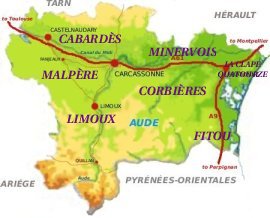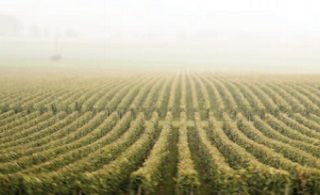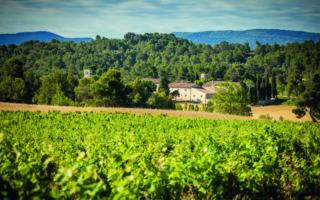An Introduction to the AOC Wines of the Aude


Fitou, Corbi
For centuries the Languedoc Roussillon region has been famed for its ideal vine growing conditions, and today it is one of the most important wine making areas of France. Due to its ideal Mediterranean climate and diverse landscape, the region produces a vast range of wines to suit every palette. Indeed one needs only to look at the wine section of any local supermarket to gauge the extent of the variety of wine available here, from full-bodied reds and crisp, sweet dessert wines to the region’s very own delightful sparkling wine, the Blanquette de Limoux! Each of the five departments in the Languedoc Roussillon have their own distinctive wines, and for wine-lovers there could be nothing better than to plan a tour of the region tasting the various selections and meeting their proud and passionate producers.
But where should one start? Here we look at the main characteristics of the AOC wines of the Aude – a department of the Languedoc Roussillon that is not very well known, and yet one that produces an enormous amount of its wine. With well over a third of its land devoted to vine growing, and where the wine industry provides a large portion of the department’s economy, there are a myriad different types of wine to discover. In this article we will only concentrate on the major Appellations. The Appellation d’Origine Controlées (AOC) is the highest classification for French wines, and the governing bodies use very strict criteria regarding not only the taste and quality of the wine, but also the quality of the grape variety and its cultivation and production, when deciding whether a particular wine can be awarded the classification. By and large, the AOC classifications are grouped into areas within a region – making it quite easy to plan a tour – and the Aude is home to eight AOC areas: La Clape, Quatourze, Corbières, Fitou, Minervois, Limoux, Côtes de Malepère and Cabardès.

La Clape and Quatourze
These AOC wines, made from vines planted on the massif du Clape just north of Narbonne, also come under the umbrella AOC Coteaux du Languedoc classification which groups together several smaller territories around Montpellier and the Mediterranean. The red and rosé wines are mainly elaborated from Carignan, Grenache, Lladoner Pelut, Cinsault and Syrah grape varieties and are structured, subtle and aromatic whilst the white wines tend to be more fruity, with the predominant use of Grenache and Bourboulenc (also known as Malvoisie) grape varieties.
Corbières
The vineyards here are tightly knit onto the scrubland of the Corbières hills which run down through the east of the Aude to the Mediterranean coast. More than 90% of the wines produced here are light, fruity red wines elaborated from Carignan, Grenache, Lladoner Pelut, Mourvèdre, Black Picpoul, Terret, Syrah, Cinsault, Maccabeu, Bourboulenc and Grenache Grey varieties. The few white wines that are produced are mainly dry and made with Bourboulenc , Clairette, Maccabeu, white Muscat, white Picpoul, white Terret, Marsanne, Roussanne and Vermentino (also known as Rolle) grapes.
Fitou
Below the Corbières and along the Mediterranean coast, the Fitou area comprises one of the oldest and best known AOC wines in the Aude, having received its certification in 1948. The red wine produced on the rocky, arid slopes here is a blended from Carignan, Grenache, Mourvèdre, Syrah and Lladoner Pelut varieties and its deep, fruity and spicy taste goes on improving with age.
Minervois
Situated between the Black Mountains and the River Aude the Minervois produces reds which can be light and fruity, although you can also find reds which age into fuller flavours. Here red and rosé wines are produced using Grenache, Syrah, Mourvèdre, Lladoner Pelut, Carignan, Cinsault, black Picpoul, Terret and Aspiran varieties. The white wine here tends to be more smooth and elegant than the reds and is blended from Grenache, Bourboulenc, Maccabeu, Marsanne, Roussanne and Vermentino varieties.

Limoux
There has been an AOC classification in Limoux since 1938 in celebration of the region’s very own delightful light and fruity sparkling wines known as Blanquette and Crémant, which come in sec, demi-sec and brut forms. They are made almost exclusively from the Mauzac grape variety, with some blends also using Pinot Noir, Chardonnay and Chenin. These two sparkling wines account for 95% of the wine production in this area south of Carcassonne along the valley of the River Aude. The area also produces some fine still wines, again using mainly Mauzac, Chardonnay and Chenin grape varieties.
Côtes de Malepère
At the meeting point of grape varieties from the Atlantic and Mediterranean coasts, the vineyards in this area south west of Carcassonne produce intense and spicy reds from Merlot, le Cot and Cinsault grape varieties and lighter rosés elaborated from Cinsault, Grenache and Lladoner Pelut varieties.
Cabardès
The Cabardès area is also at the crossroads of the Atlantic grape varieties such as Merlot, Cabernet Sauvignon and Franc, and the Mediterranean varieties of Syrah and Grenache. These two distinct groups are blended along with a hint of Cot and Fer Servadou varieties to produce rich yet balanced wines. Recent investment and a lot of dedication on the part of the wine makers here to take advantage of this fantastic location has resulted in red wines that have received many accolades (including 14 gold medals at the Concours Général Agricole in Paris) for their full-bodied tastes and complex aromas. The area is also noted for its fine dry rosés.
READ MORE
• AOC wines in the Hérault and Gard
• AOC wines in the Roussillon/ Pyrénees-Orientales
note – over the past few years there has been a lot of speculation and reports of changes to be made in the AOC system, as yet to be fully clarified – the author apologises, therefore, for any confusion or misleading information, 2010
Places to Stay for Languedoc Wine-tasting Holidays
The variety and quality of Languedoc-Roussillon wines is endless – so, whilst planning your tour of the region, consider staying at one or more of these wonderful places where your hosts have local knowledge of all the best vineyards in the region.
Wine-tasting Accommodation – Self-Catering
Wine-tasting Accommodation – Bed & Breakfast
Share to: Facebook Twitter LinkedIn Email
More in aude, holiday accommodation, investment, land, languedoc, river, wine
By FrenchEntrée
Leave a reply
Your email address will not be published. Required fields are marked *



